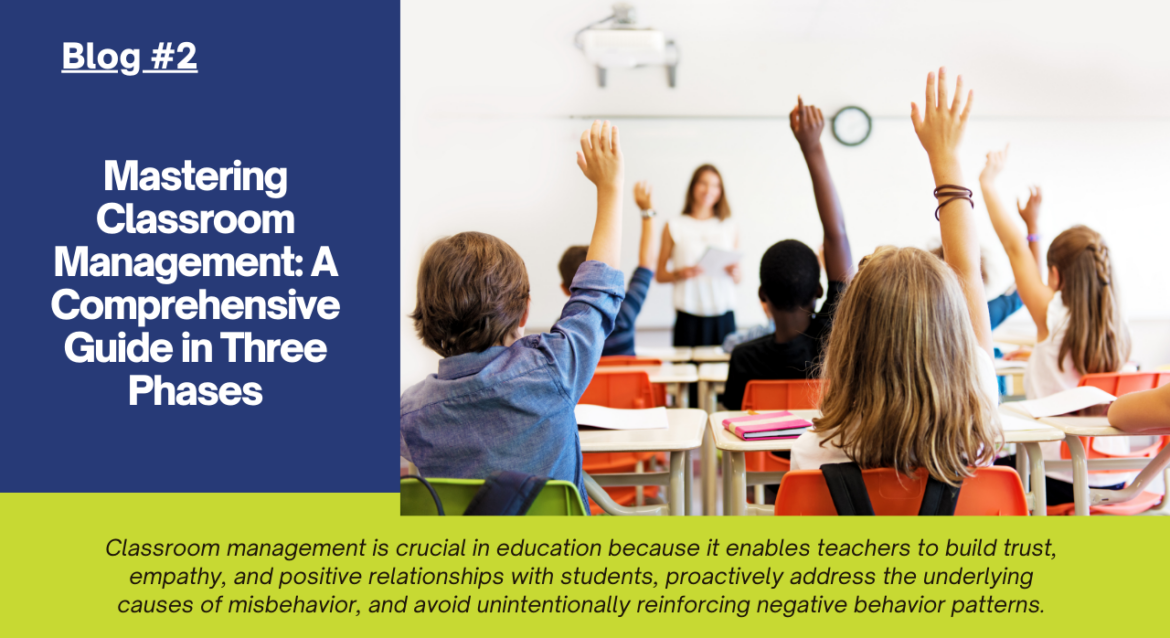
Think about your favorite classroom as a child — the one where everyone paid attention, got along, and learning felt like an adventure. That’s the magic of classroom management. It’s like the conductor of an orchestra, making sure everything runs smoothly throughout a concert.
Question: Why is classroom management important in education?
Statement: Classroom management is crucial in education because it enables teachers to build trust, empathy, and positive relationships with students, proactively address the underlying causes of misbehavior, and avoid unintentionally reinforcing negative behavior patterns. Effective classroom management fosters an environment where students can develop the social and emotional skills necessary for self-regulation, leading to a more conducive and productive learning experience.
In this blog, we’ll break down classroom management into three phases to help you maximize instruction. Whether you’re just starting or have been teaching for a while, these steps will help you create a productive learning environment. STRIVE will lead you through an exploration of each phase, from building strong foundations to improving your classroom management skills and finally, fine-tuning your teaching to become the best you can be.
At the end of the blog, there is a link to a comprehensive guide flipbook, which includes specific details, additional resources, a self-assessment, and entry points into the three phases. It is a resource designed to be used by teachers, leaders, and coaches.
For teachers grappling with a hectic classroom or striving to enhance their management skills, the guide is a blueprint. It’s what you turn to when your principal suggests that your classroom management could use some reinforcement. It’s a structured approach that transforms challenges into opportunities for growth and development.
Principals will find this guide invaluable for supporting teachers. It offers a comprehensive framework to assess classroom management techniques and provide constructive feedback. With this guide, principals can help teachers strengthen their classroom management skills and thus their teaching and student learning.
For coaches, this narrative and guide serves as a road map to mentor teachers. It’s a resource to pinpoint areas for improvement, set realistic goals, and offer the support needed to navigate the journey toward masterful classroom management.
So, let’s get started!
Phase 1: Foundation
The foundation of effective classroom management lies in establishing a firm ground of clear rules and expectations. Imagine a teacher leading a class in crafting a code of conduct. This collaborative effort means that each student has a hand in shaping the very rules they’ll follow, fostering a greater sense of ownership and accountability. It’s in these early stages that a teacher plants the seeds of respect, responsibility, and safety, with each rule acting as a pillar supporting the learning environment.
Consider how a teacher organizes the physical space of the classroom to optimize learning. A U-shaped arrangement might be chosen to encourage open dialogue, while designated areas for different activities can streamline transitions and maintain order. The cleanliness and orderliness of the space are maintained not just by the teacher but by the students, who take pride in their learning environment.
Routines and procedures are the rhythms that keep the classroom running smoothly. A teacher adept in classroom management will have a plethora of routines, from the morning welcome to the end-of-day reflection. These routines are practiced and perfected, becoming second nature to the students, allowing for a classroom where the day’s lessons flow seamlessly.
And at the heart of it all is the relationship between teacher and student. Picture a classroom where every student feels seen and heard, where circle time and one-on-one interactions are as much a part of the day as reading and math. It’s here that positive recognition and strength-based language are not just strategies but the very language through which a teacher communicates, nurturing a classroom where every student feels valued and understood.
Phase 2: Refine
With the foundation set, a teacher’s journey continues with proactive management strategies. This is the phase where a teacher becomes a visionary, anticipating potential disruptions before they occur and equipping students with the skills to resolve conflicts and manage their own behaviors. It’s a proactive approach that mitigates issues before they escalate, ensuring that learning is seldom interrupted.
The development of a positive behavior support plan is akin to drafting a guidebook for success. Here, expectations are not just communicated but celebrated. Positive behaviors are reinforced with immediate praise and reflection time, creating a classroom culture that’s as much about learning from mistakes as it is about celebrating triumphs.
Differentiated instructional methods are the teacher’s tools for ensuring that every student’s learning needs are met. It’s recognizing that each student is an individual and tailoring instruction to meet them where they are. Through active participation, small groups, and flexible grouping, a teacher ensures that each lesson reaches every student, minimizing negative behaviors by engaging students in a way that speaks to them.
Building a sense of community within the classroom is what transforms a group of students into a unified whole. Cultural sharing activities, team-building exercises, and inclusive discussions are the threads that weave a tapestry of community, one where every student feels a sense of belonging and contribution.
Formative assessment strategies are the feedback mechanisms that inform a teacher’s instruction. Through quizzes, reflections, and discussions, a teacher gauges understanding and adjusts teaching accordingly, ensuring that the path of learning is always moving forward.
And let’s not forget the crucial role of communication with parents. Regular updates, classroom newsletters, and opportunities for parent involvement create a partnership that extends the learning community beyond the classroom walls.
Phase 3: Enhance
As a teacher’s classroom management skills grow, so does the capacity for enhancing student leadership. Envision a classroom where students take the helm as class representatives or peer mentors, leading discussions and guiding their classmates. It’s a space where leadership is not just encouraged but cultivated, with students feeling empowered to take an active role in their education.
Fostering student autonomy is about giving students choices, encouraging independent projects, and guiding problem-solving activities. Teacher supports students in becoming self-directed learners, prepared to navigate the complexities of the world with confidence.
Encouraging and extending critical thinking is the process of deepening students’ intellectual engagement. Through discussion, debate, and problem-based learning, students are challenged to think deeply, analyze rigorously, and engage fully with the material.
And at the core of a teacher’s continued growth is reflective practice. It’s in the quiet moments of reflection, the feedback sessions, and peer observations that a teacher contemplates their practice, seeking always to improve, to grow, and to become the best educator they can be.
Conclusion
In conclusion, we’ve explored the three phases of STRIVE’s Classroom Management system. Each phase is a crucial step on the journey to becoming a more effective teacher and creating a productive learning environment. Remember, the key to success in classroom management is continuous improvement and adaptability. As you gain experience, your strategies may evolve, and that’s perfectly normal.
To dive deeper into these strategies and access a self-assessment rubric, we invite you to explore STRIVE’s Elementary Classroom Management Guide Flipbook. It’s packed with detailed examples and additional resources that can be invaluable in your teaching journey. If you would like a PDF version of the Flipbook, please email STRIVE at [email protected]. Happy teaching!
We must take care of the teachers, leaders, and coaches that take care of our children.
-Debbie
Our aim is simple: to provide as many helpful resources as possible to teachers, leaders, and coaches. Every comment you make and every share helps us achieve this goal.
Leave a Comment: Your thoughts and experiences are valuable to us and other readers. Join the conversation and help us all learn more!
Share with Others: Know other teachers who could benefit from our resources? Spread the word and help us reach more educators



2 Comments
Amelia Downey
Amazing resource! Thank you so much for sharing this!
Debbie
Thanks Amelia!